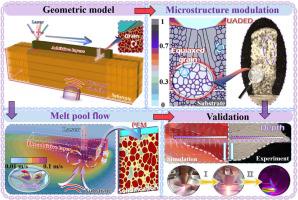定向能沉积中超声振动对超细晶粒的控制
IF 9.4
1区 工程技术
Q1 ENGINEERING, MECHANICAL
International Journal of Mechanical Sciences
Pub Date : 2025-10-09
DOI:10.1016/j.ijmecsci.2025.110925
引用次数: 0
摘要
显微组织粗化和非均匀性是增材制造中不可避免的问题。为了实现超声振动对DED中超细颗粒的控制,设计了超声辅助定向能沉积(uded)实验,建立了超声-热耦合模型。基于所建立的模式,设计了在超声振动下制备AM样品的实验,获得了超细晶粒。超声振动调节晶粒形貌。当振动幅值为30 μm、振动频率为20 kHz、扫描速度为6 mm/s、激光功率为800 W时,与传统DED相比,平均晶粒尺寸减小了52.9%,等轴晶粒面积比例增加了41.2%。结合实验观测,该耦合模型为微观结构控制提供了过程窗口,计算精度达到96.8%。在超声激励下,工件温度降低了230 K,成核率提高了36.3%。该模型表明,UA通过改善熔池流动来增强非均质成核,为微观结构控制提供了新的途径。本文章由计算机程序翻译,如有差异,请以英文原文为准。

Ultrafine grain control by ultrasonic vibrations in directed energy deposition
Microstructural coarsening and heterogeneity are unavoidable problems in additive manufacturing (AM). To realize ultrafine grain control by ultrasonic vibrations in DED, we designed ultrasonic-assisted directed energy deposition (UADED) experiment and established an ultrasonic-heat coupling model. Based on the established patterns, experiments were designed to fabricate AM samples under ultrasonic vibrations, and ultrafine grains were obtained. Grain morphology was regulated by ultrasonic vibrations. Compared with traditional DED, the average grain size is decreased by 52.9 % and the area proportion of equiaxed grain is increased by 41.2 % in case of 30 μm of vibration amplitude, 20 kHz of vibration frequency, 6 mm/s of scanning speed, and 800 W of laser power. Combined with experimental observations, the coupling model provides the process window for the microstructural control, with the computational accuracy reaching 96.8 %. The workpiece temperature is reduced by 230 K and the nucleation rate is increased by 36.3 % under ultrasonic excitation. The model illustrates that UA enhances heterogeneous nucleation by improving melt pool flow, providing a novel approach for microstructure control.
求助全文
通过发布文献求助,成功后即可免费获取论文全文。
去求助
来源期刊

International Journal of Mechanical Sciences
工程技术-工程:机械
CiteScore
12.80
自引率
17.80%
发文量
769
审稿时长
19 days
期刊介绍:
The International Journal of Mechanical Sciences (IJMS) serves as a global platform for the publication and dissemination of original research that contributes to a deeper scientific understanding of the fundamental disciplines within mechanical, civil, and material engineering.
The primary focus of IJMS is to showcase innovative and ground-breaking work that utilizes analytical and computational modeling techniques, such as Finite Element Method (FEM), Boundary Element Method (BEM), and mesh-free methods, among others. These modeling methods are applied to diverse fields including rigid-body mechanics (e.g., dynamics, vibration, stability), structural mechanics, metal forming, advanced materials (e.g., metals, composites, cellular, smart) behavior and applications, impact mechanics, strain localization, and other nonlinear effects (e.g., large deflections, plasticity, fracture).
Additionally, IJMS covers the realms of fluid mechanics (both external and internal flows), tribology, thermodynamics, and materials processing. These subjects collectively form the core of the journal's content.
In summary, IJMS provides a prestigious platform for researchers to present their original contributions, shedding light on analytical and computational modeling methods in various areas of mechanical engineering, as well as exploring the behavior and application of advanced materials, fluid mechanics, thermodynamics, and materials processing.
 求助内容:
求助内容: 应助结果提醒方式:
应助结果提醒方式:


